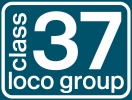
|

|
|

|
||
About The Class 37 Locomotive Group
The Class 37 Locomotive Group (C37LG) is a group of rail enthusiasts dedicated to preserving and operating working examples of English Electric Type 3 (British Rail Class 37) locomotives for the general public, and to promote their interest and history, being part of our nation's industrial and railway heritage. The C37LG is a not-for-profit organisation as well as a registered charity (reference number 1137787).
The C37LG is one of longest established diesel preservation groups in the country, and traces its history back to 1984 when a group of like-minded Class 37 "bashers" based around Norwich and Ipswich formed a group called the East Anglian Syphon Bashers (EASB). By the end of 1985, the EASB had metamorphosed into the Class 37 Group, with 'Splitbox' as the Group magazine. Things rapidly progressed over the next couple of years, including a trade stand being set up, 'Splitbox' scooping the national railway press with the BR launch of the 'Triple Grey' Railfreight livery, and, crucially, the launch of the official Preservation Fund at the Midland Railway Centre's 1988 Diesel Gala.
To counter accusations of favouritism towards the early build locos, the Group's monthly magazine changed its name in 1988, with 'Splitbox' becoming 'Syphon!' (no "panel-ist" discrimination here!). ‘Syphon!’ continues to be produced quarterly to the present day. The Group was highly active in its early days with the sales department visiting events and galas to carry out fundraising to buy their own Class 37. Several classic railtours were operated, including 'The Felixstowe Phoenix', breaking the loco-hauled drought on the Felixstowe branch, and the Settle Syphons', setting a believed Class 37 passenger speed record of 109.25mph!
Years of fundraising and hard work by Group members paid off when, in 1998, our second bid for 37003 from EWS was successful, albeit without a power unit (having been stripped for spares). The locomotive was, however, sitting on a nice set of cast CP7 bogies, usually fitted to Class 37/3 onwards (and which C37LG volunteers later discovered upon inspection that these were the set originally fitted under 50149 during its freight trials in the 1980s!).
After being declared asbestos free at the MC Metals, Glasgow, 37003 was moved to the East Anglian Railway Museum (EARM) in Chappel. Here, major restoration work began from the ground upwards. A number of spares were acquired from C.F. Booths to complete the loco, particularly the cabs. The loco was then repainted into BR Green and it was during this process that the mountings for the original 1963 nameplates, 'The 1st East Anglian Regiment', were uncovered. After a visit to the Wigan CRDC in July 2002, the Group acquired the power unit from 37073 which was subsequently fitted into 37003. After several months of hard work, 37003 was started up at Chappel for the first time in preservation, on 18th October 2003.
Meanwhile, the short running line of the EARM meant that thoughts soon turned to whether it was a suitable long-term base. After a series of negotiations, the Group moved 37003 to the Wensleydale Railway, in North-East England, in January 2004. Repainted into BR blue, the loco was put to regular use on Wensleydale PW trains before finally, six years after purchase by the Group, 37003 hauled her first passenger train on 23rd October 2004, followed by successful peak-season Summer trains in 2005.
Following a change of traction policy, no duties were available for 37003 (and other locos) so the Group moved 37003 to the fledging Weardale Railway in August 2006, where it had worked a number of passenger trains that year, which included rescuing timetabled 'Santa Specials' when a steam loco was failed in service. However, a change of management meant there was less emphasis on privately-owned heritage diesel use, and in December 2007 37003 moved to a temporary home at Locomotion in Shildon before moving to her current home at Dereham on the Mid-Norfolk Railway in February 2009.
Upon arrival at Dereham, the loco’s main generator bearing was replaced in situ before the loco was restored as ‘Dutch’ liveried 37360 (renumbered with fictitious license due to the CP7 bogies) for the MNR’s Class 37 Golden Jubilee event in September 2010, where the loco worked her first revenue-earning passenger train since December 2006. In 2012 the Group was approached by a local high school with a view to name the loco as part of their centenary celebrations. Repainted into BR blue and renumbered 37003 once more, the loco was named ‘Dereham Neatherd High School 1912-2012’ at a ceremony at Dereham station on 6th July 2012.
In December 2013, 37003 was taken out of traffic due to a leaking cylinder liner (which became multiple on further investigation). Work began to repair these at Dereham but by 2016 it became apparent the Group would require assistance; thus Project 3-60 was launched. The aim was to repair the engine and undertake a full and thorough restoration of the bodywork, returning the loco to “as-built” condition in time for its 60th anniversary in December 2020. The loco was moved to the premises of UKRL in Leicester (via the GCRN) in September 2017 where it remains today. The discovery of a cracked engine crank and the COVID-19 crisis of 2020 have meant the loco is unlikely to be finished until 2021. You can help support our efforts by donating, becoming a member, or by using our online shop. Once restored, D6703 (as she will become) will see regular use at Dereham and it is also intended to visit other railways on the gala circuit.